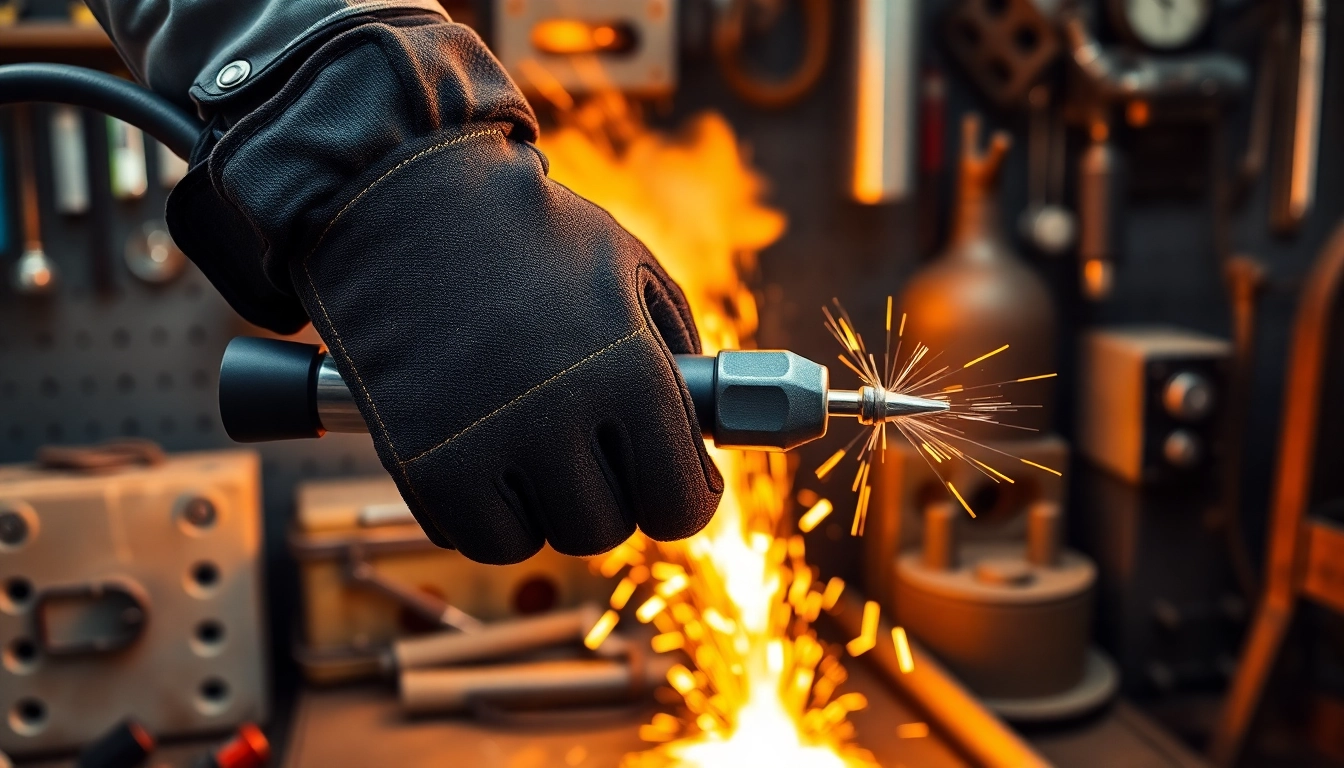Understanding Different Types of Welding Gloves
Welding gloves are a crucial piece of personal protective equipment (PPE) for anyone engaged in metalworking, including both amateur and professional welders. Their primary function is to protect the hands from heat, sparks, and electrical hazards inherent in various welding processes. However, not all welding gloves are created equal; they are designed to cater to different welding methods and provide varying levels of protection, comfort, and dexterity. In this article, we will delve into the different types of welding gloves, examining their materials, features specific to MIG and TIG welding jobs, and safety standards that govern their use.
Material Options for Welding Gloves
The material of welding gloves significantly influences their effectiveness and suitability for specific tasks. Here are some common materials used in the manufacturing of welding gloves:
- Leather: The most prevalent material due to its natural heat resistance and durability. Common types include cowhide, pigskin, and goat leather. Cowhide gloves are particularly popular due to their balance of cost and performance.
- Synthetic Materials: Gloves made from synthetic fibers, such as Kevlar, offer high heat resistance and increased strength, making them ideal for tasks that require additional dexterity.
- Aluminized Fabric: Ideal for high-heat applications, these gloves provide excellent heat reflective properties, protecting from intense heat without compromising mobility.
Features of MIG vs. TIG Welding Gloves
MIG (Metal Inert Gas) and TIG (Tungsten Inert Gas) welding gloves differ primarily in their design to accommodate the requirements of each welding method:
- MIG Welding Gloves: These gloves focus on durability and heat resistance while maintaining a degree of dexterity. They often feature a keystone thumb design, which allows for better grip and movement. MIG gloves are usually heavier to protect against the weld splatter that can occur during the process.
- TIG Welding Gloves: TIG welding demands higher precision, so these gloves are designed to be thinner and more flexible than MIG gloves. They often have a tighter fit to enhance tactile feedback, enabling the welder to manipulate the torch and filler rod with greater accuracy.
Safety Standards and Certifications
Before purchasing welding gloves, it’s important to consider safety standards. Look for gloves that comply with American National Standards Institute (ANSI) and Occupational Safety and Health Administration (OSHA) regulations. The ANSI/ISEA 105 standard is particularly significant as it certifies the performance of protective clothing during handling and welding tasks.
Certification labels denote maximum heat and flame resistance, abrasion ratings, and puncture resistance which can influence the choice of gloves depending on the specific risks of the welding environment.
How to Choose the Best Welding Gloves for Your Needs
Selecting the right welding gloves may seem straightforward but involves assessing several critical factors. Here’s a guide on how to make an informed decision.
Assessing Your Welding Techniques
The type of welding you perform predominantly should guide your glove selection:
- MIG Welding: Look for gloves that offer a balance between flexibility and protection, as you will need to switch frequently between holding the gun and moving the metal.
- TIG Welding: Opt for gloves that allow for maximum dexterity, as detailed movements are integral to this technique. A snug fit can improve your control over the welding process.
- Stick Welding: Involves heavier gloves that provide significant protection against sparks and heat. Ensure that they have a tight fit at the wrists to prevent debris from entering.
Factors to Consider: Fit and Comfort
Comfort is paramount when selecting welding gloves, as you may wear them for extended periods. Here are key factors to assess:
- Size: Welding gloves should fit snugly but not so tight that finger movement is restricted. Consider trying on various sizes before making a final choice.
- Padded Interiors: Some gloves feature padded linings for additional comfort, which can reduce fatigue during long welding sessions.
- Wrist Length: A longer gauntlet provides added protection by covering more of the arm, preventing sparks and slag from coming into contact with your skin.
Budgeting for Quality Gloves
While it may be tempting to choose cheaper gloves, investing in high-quality options can provide better protection and longevity. Understand that welding involves risks that can be mitigated by appropriate PPE. Thus, consider the following:
- Durability: Higher-priced gloves often last longer and provide better protection, ultimately resulting in a lower cost over time.
- Use Frequency: For professionals who weld daily, spending on premium gloves is wise. For casual welders, a mid-range option may suffice.
Caring for Your Welding Gloves
Proper maintenance extends the life of welding gloves and ensures optimal protection. Here are some tips for caring for your welding gloves:
Proper Maintenance and Storage
After each use, gloves should be inspected for signs of damage such as burns or tears. Clean them according to the manufacturer’s instructions, which may involve wiping them down with a damp cloth. Store gloves in a cool, dry place away from direct sunlight and away from sources of heat.
Signs of Wear and When to Replace
Recognizing when to replace your welding gloves is crucial for safety. Look for:
- Visible holes or tears
- Loss of flexibility or stiffness
- Discoloration indicating weakened materials
Cleaning Tips for Longevity
This includes:
- Using mild soap and water for leather gloves. Avoid harsh chemicals that may degrade the material.
- Drying gloves naturally, avoiding direct heat sources.
- Regularly applying leather conditioner to maintain flexibility and hinder cracking.
Why High-Quality Welding Gloves Matter
Choosing high-quality welding gloves significantly impacts the safety and efficiency of your welding tasks. Let’s explore some reasons why high standards should not be overlooked.
The Impact of Poor Quality on Safety
Substandard gloves can expose welders to serious injuries, such as burns or electric shock. Gloves that are made from inferior materials are more likely to fail under extreme temperatures. It’s vital to remember that safety must always take precedence over cost.
Performance vs. Price: Making Informed Choices
While price is an undeniable factor, performance should be prioritized over savings. A small investment in a pair of high-quality gloves can prevent more significant injury-related costs, such as medical expenses and downtime.
Reviews of Top-Rated Welding Gloves
Before selecting your gloves, consider reviewing market opinions, such as:
- TOPDC Welding Gloves – High heat resistance and durability.
- Black Stallion – Noted for comfort and effectiveness in various welding techniques.
- MillerWelds – Highly rated for offering excellent dexterity without compromising heat resistance.
These gloves are sampled among the highest-rated products, ensuring users gain insights into performance and usability.
Innovative Features in Modern Welding Gloves
As technology advances, so do the features found in welding gloves. Modern innovations have created options that increased comfort and protection levels significantly.
Advanced Materials and Technologies
Innovative materials such as flame-retardant coatings and reinforcement stitching improve durability while ensuring flexibility. Some gloves now incorporate breathable inner linings that wick moisture away, thus providing comfort during extended use.
Customizable Glove Options for Professionals
Many manufacturers now offer customizable glove options tailored to specific requirements. Welders can choose additional features such as reinforced palms, custom sizing options, and even personalized designs.
Comparative Analysis with Competitor Products
When comparing different manufacturers, consider performance metrics, user feedback, and industry certifications. Products from reputed brands often undergo rigorous testing, ensuring they meet or exceed safety standards. Being informed about the differences between available products empowers welders to select the solutions that best meet their unique needs.
Conclusion
Welding gloves are more than just protective gear; they are critical to safely executing high-risk tasks in the welding industry. Understanding the specific types, materials, and features available can significantly enhance both performance and safety on the job. Investing in the right pair of welding gloves should reflect an understanding of the tasks at hand, ensuring that welders are protected while achieving the precision required for their work.



